hood open HONDA S2000 2003 1.G Owners Manual
[x] Cancel search | Manufacturer: HONDA, Model Year: 2003, Model line: S2000, Model: HONDA S2000 2003 1.GPages: 280, PDF Size: 3.9 MB
Page 122 of 280

Bef ore you begin driving your Honda,
youshouldknowwhatgasolineto
use, and how to check the levels of
important f luids. You also need to
know how to properly store luggage
or packages. The inf ormation in this
section will help you. If you plan to
add any accessories to your vehicle,
please read the inf ormation in this
section f irst..............................
Break-in Period .120
.........................................
Gasoline .120
.........
Service Station Procedures . 121
................
Filling the Fuel Tank . 121
....................
Opening the Hood .122
...............................
Oil Check .123
.........
Engine Coolant Check . 124
...............................
Fuel Economy .125
............................
Car Condition .125
...........................
Driving Habits .125
...
Accessories and Modif ications . 126
................................
Accessories .126
............................
Modif ications .127
...
Additional Safety Precaution . 127
.............................
Carrying Cargo .128
.....................
General Precautions .131
Bef ore Driving
Bef ore Driving119
Page 125 of 280
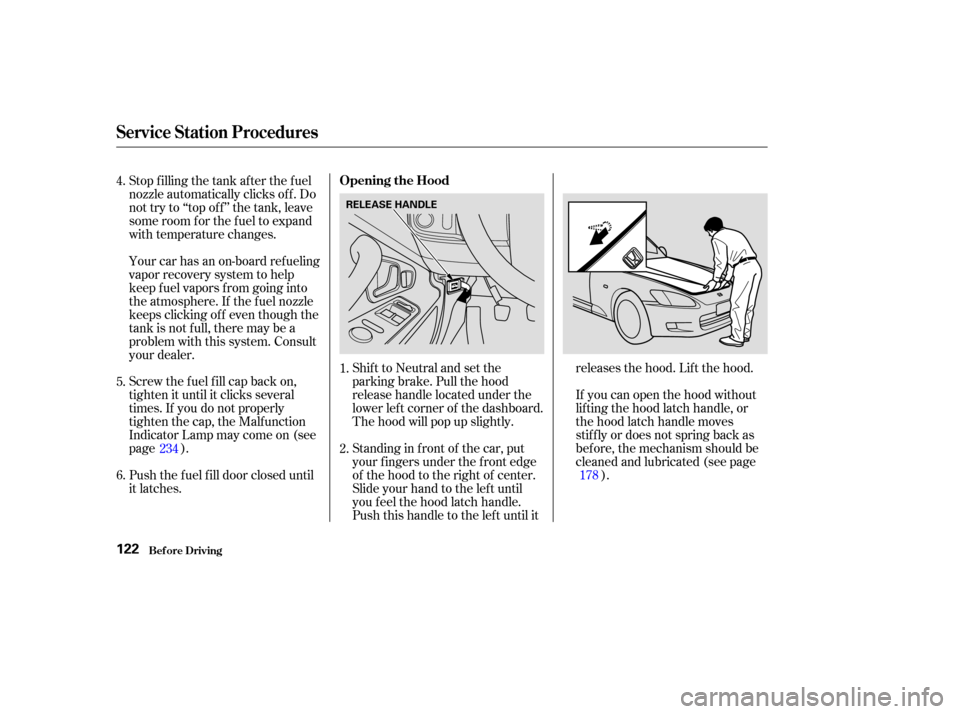
Standing in f ront of the car, put
your f ingers under the f ront edge
of the hood to the right of center.
Slide your hand to the lef t until
you f eel the hood latch handle.
Push this handle to the lef t until itreleases the hood. Lif t the hood.
If you can open the hood without
lifting the hood latch handle, or
the hood latch handle moves
stif f ly or does not spring back as
bef ore, the mechanism should be
cleaned and lubricated (see page
).
Stop f illing the tank af ter the f uel
nozzle automatically clicks of f . Do
not try to ‘‘top off’’ the tank, leave
some room f or the f uel to expand
with temperature changes.
Shif t to Neutral and set the
parking brake. Pull the hood
release handle located under the
lower lef t corner of the dashboard.
The hood will pop up slightly.
Push the f uel f ill door closed until
it latches. Screw the f uel f ill cap back on,
tighten it until it clicks several
times. If you do not properly
tighten the cap, the Malfunction
Indicator Lamp may come on (see
page ). Your car has an on-board ref ueling
vapor recovery system to help
keep f uel vapors f rom going into
the atmosphere. If the fuel nozzle
keeps clicking of f even though the
tank is not f ull, there may be a
problem with this system. Consult
your dealer. 1.
4.
5.
2.
6. 178
234
Service Station Procedures
Bef ore Driving
Opening the Hood
122
RELEASE HANDLE
Page 170 of 280
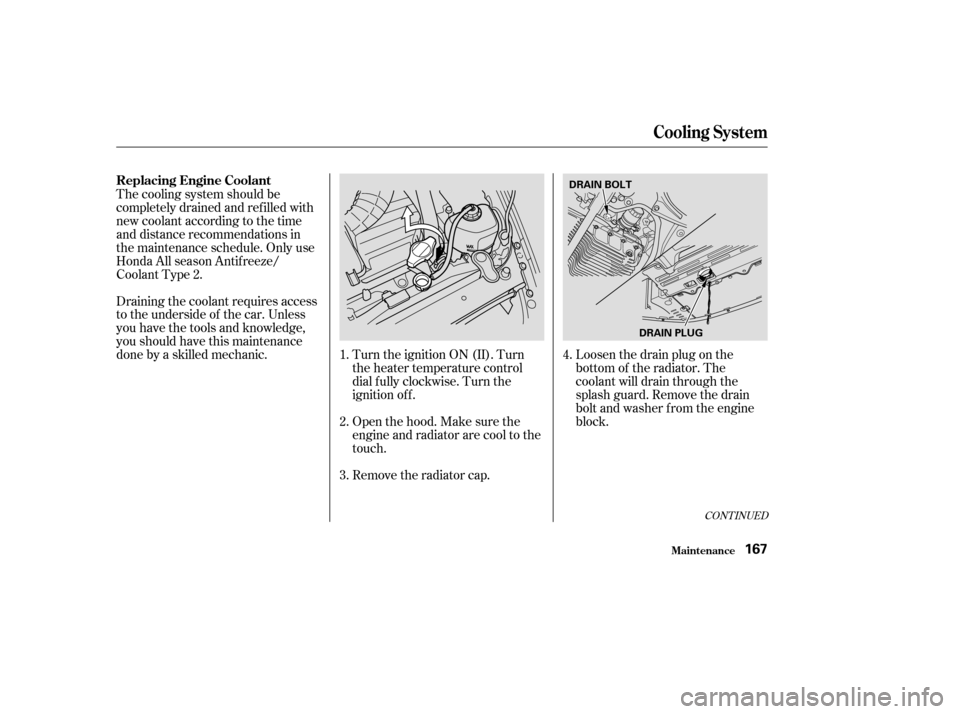
Turn the ignition ON (II). Turn
the heater temperature control
dial f ully clockwise. Turn the
ignition of f .
Openthehood.Makesurethe
engine and radiator are cool to the
touch.
Remove the radiator cap.Loosen the drain plug on the
bottom of the radiator. The
coolant will drain through the
splash guard. Remove the drain
bolt and washer f rom the engine
block.
Thecoolingsystemshouldbe
completely drained and ref illed with
new coolant according to the time
and distance recommendations in
the maintenance schedule. Only use
Honda All season Antif reeze/
Coolant Type 2.
Draining the coolant requires access
to the underside of the car. Unless
you have the tools and knowledge,
you should have this maintenance
done by a skilled mechanic.
1.
2.
3. 4.
CONT INUED
Replacing Engine Coolant
Cooling Syst em
Maint enance167
DRAIN BOLT
DRAIN PLUG
Page 190 of 280
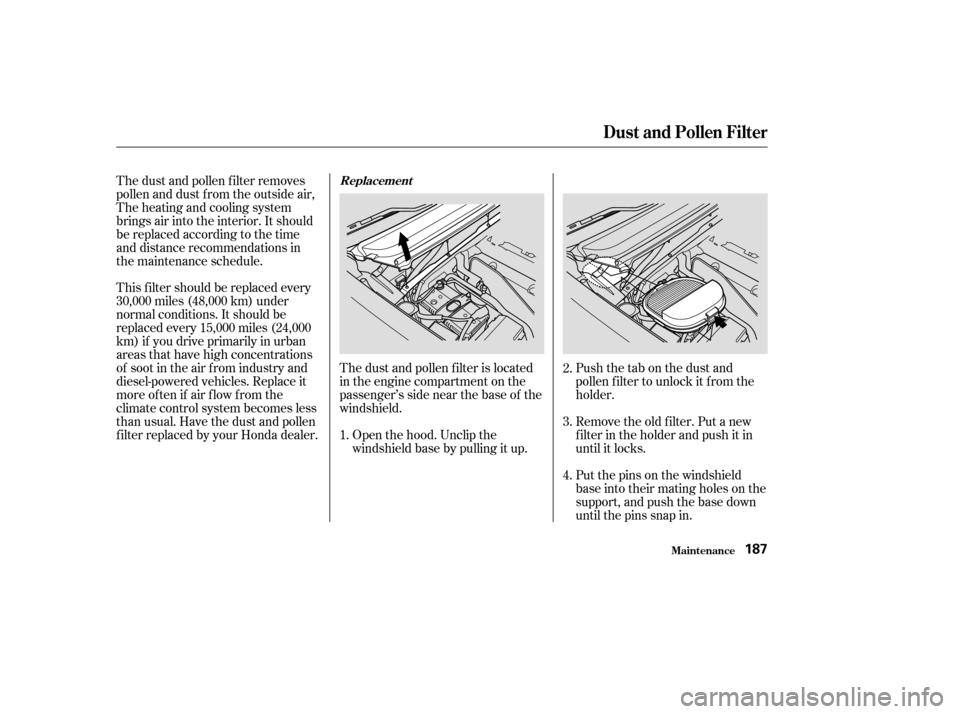
Open the hood. Unclip the
windshield base by pulling it up.Put the pins on the windshield
base into their mating holes on the
support, and push the base down
until the pins snap in. Remove the old f ilter. Put a new
f ilter in the holder and push it in
until it locks.
The dust and pollen f ilter is located
in the engine compartment on the
passenger’s side near the base of the
windshield.
Push the tab on the dust and
pollen f ilter to unlock it f rom the
holder.
This f ilter should be replaced every
30,000 miles (48,000 km) under
normal conditions. It should be
replaced every 15,000 miles (24,000
km) if you drive primarily in urban
areas that have high concentrations
of soot in the air f rom industry and
diesel-powered vehicles. Replace it
more of ten if air f low f rom the
climate control system becomes less
than usual. Have the dust and pollen
f ilter replaced by your Honda dealer. The dust and pollen f ilter removes
pollen and dust f rom the outside air,
The heating and cooling system
brings air into the interior. It should
be replaced according to the time
and distance recommendations in
the maintenance schedule.
1.2.
3.
4.
Maint enance
Replacement
Dust and Pollen Filter
187
Page 202 of 280

Open the hood.
Remove the electrical connector
f rom the bulb by squeezing the
connector to unlock the tab, then
slide the connector of f the bulb.Remove the rubber weather seal
by pulling on the tab.
If you need to change the high
beam headlight bulb on the lef t
side, remove the coolant reserve
tank f rom its holder by pulling it
straight up. Unclip the end of the hold-down
wire f rom its slot. Pivot it out of
the way and remove the bulb
socket.Install the rubber seal over the
back of the headlight assembly.
Make sure it is right side up; it is
marked ‘‘TOP.’’ Insert the socket back into the
headlight assembly. Make sure
the bulb is installed correctly by
looking through the headlight lens.
The pins on the base of the bulb
should f it in the holes in the
headlight assembly. Pivot the hold-
down wire back in place and clip
the end into the slot.
Pull the bulb straight out of its
socket. Push the new bulb straight
into the socket until it bottoms. Push the electrical connector onto
the new bulb. Turn on the
headlights to test the new bulb.
(Lef t side)
Reinstall the radiator reserve tank.
1.
2. 3.
4.
5.6.
7.
8.
9.
Lights
Maint enance199
Page 229 of 280
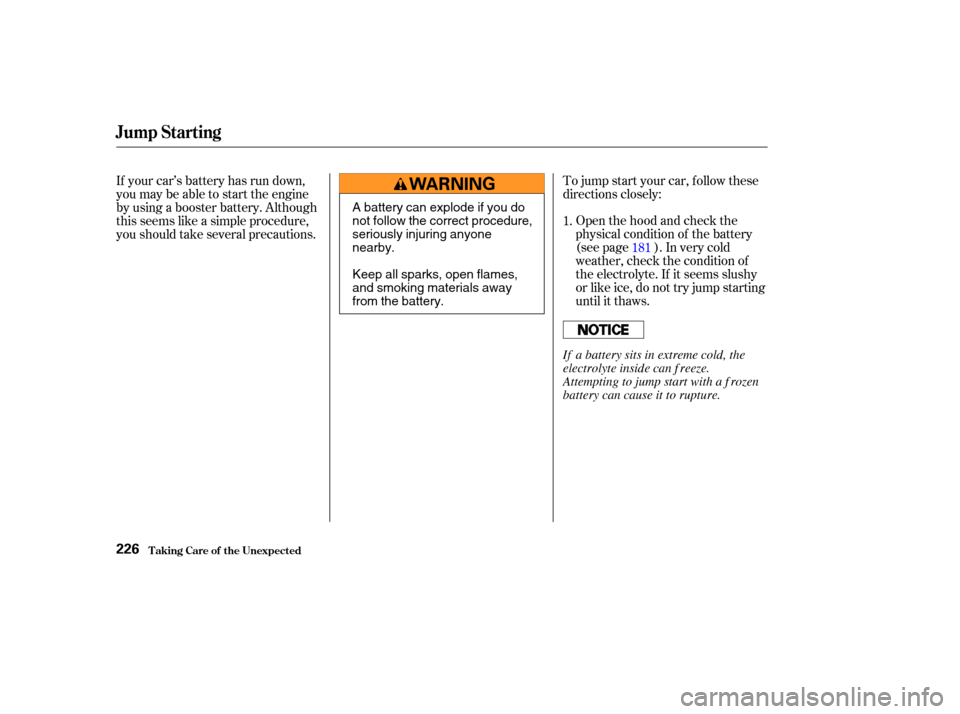
Open the hood and check the
physical condition of the battery
(see page ). In very cold
weather, check the condition of
the electrolyte. If it seems slushy
or like ice, do not try jump starting
until it thaws.
If your car’s battery has run down,
you may be able to start the engine
by using a booster battery. Although
this seems like a simple procedure,
you should take several precautions.
To jump start your car, f ollow these
directions closely:
1.
181
Jump Starting
T aking Care of t he Unexpect ed226
A battery can explode if you do
not follow the correct procedure,
seriously injuring anyone
nearby.
Keep all sparks, open flames,
and smoking materials away
from the battery.
If a battery sits in extreme cold, the
electrolyte inside can f reeze.
Attempting to jump start with a f rozen
battery can cause it to rupture.
Page 232 of 280
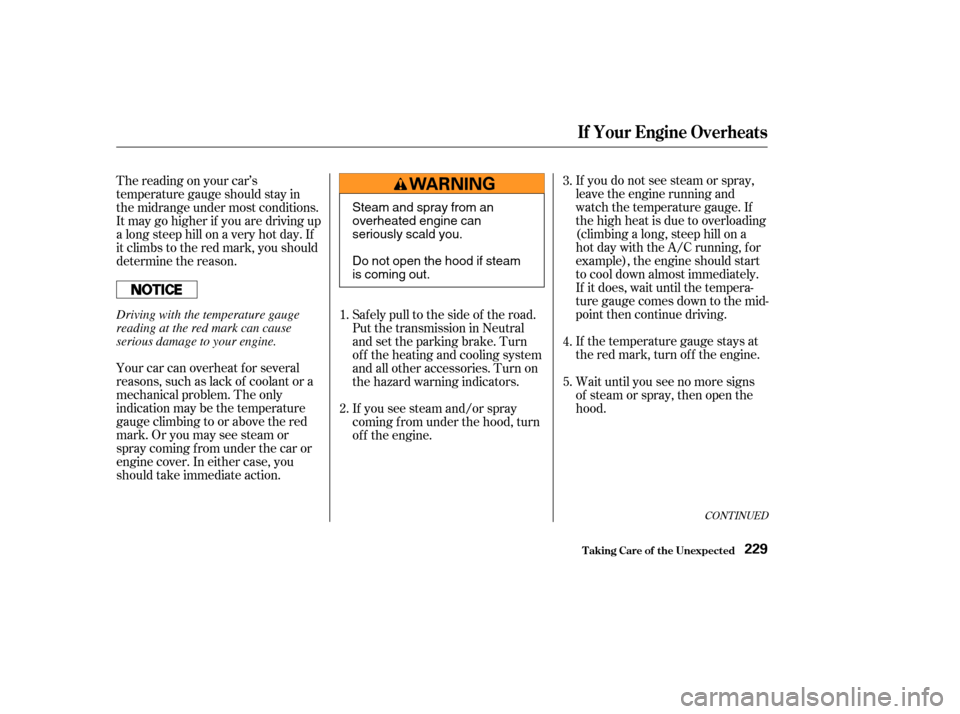
If the temperature gauge stays at
the red mark, turn of f the engine. If you do not see steam or spray,
leave the engine running and
watch the temperature gauge. If
the high heat is due to overloading
(climbing a long, steep hill on a
hot day with the A/C running, for
example), the engine should start
to cool down almost immediately.
If it does, wait until the tempera-
ture gauge comes down to the mid-
point then continue driving.
Your car can overheat f or several
reasons, such as lack of coolant or a
mechanical problem. The only
indication may be the temperature
gauge climbing to or above the red
mark. Or you may see steam or
spray coming f rom under the car or
engine cover. In either case, you
should take immediate action. The reading on your car’s
temperature gauge should stay in
the midrange under most conditions.
Itmaygohigherif youaredrivingup
a long steep hill on a very hot day. If
it climbs to the red mark, you should
determine the reason. Saf ely pull to the side of the road.
Put the transmission in Neutral
and set the parking brake. Turn
of f the heating and cooling system
andallotheraccessories.Turnon
the hazard warning indicators.
If you see steam and/or spray
coming f rom under the hood, turn
of f the engine.Wait until you see no more signs
of steam or spray, then open the
hood.
1. 3.
4.
5.
2.
CONT INUED
If Your Engine Overheats
T aking Care of t he Unexpect ed229
Steam and spray from an
overheated engine can
seriously scald you.
Do not open the hood if steam
is coming out.
Driving with the temperature gauge
reading at the red mark can cause
serious damage to your engine.
Page 235 of 280
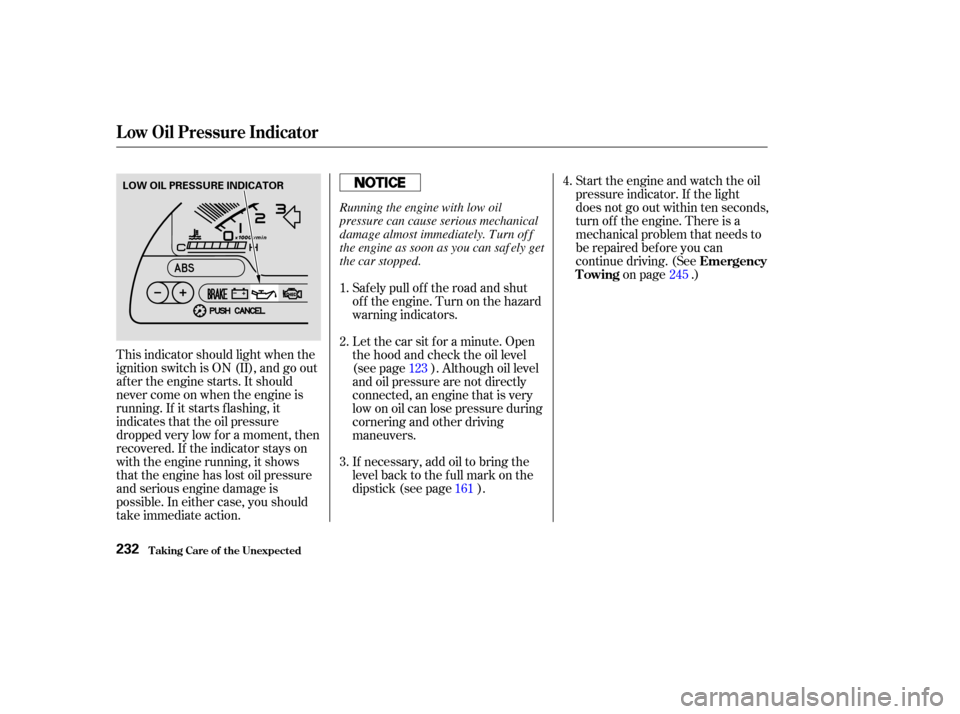
This indicator should light when the
ignition switch is ON (II), and go out
af ter the engine starts. It should
never come on when the engine is
running. If it starts f lashing, it
indicates that the oil pressure
dropped very low f or a moment, then
recovered. If the indicator stays on
with the engine running, it shows
that the engine has lost oil pressure
and serious engine damage is
possible. In either case, you should
take immediate action.Start the engine and watch the oil
pressure indicator. If the light
does not go out within ten seconds,
turn of f the engine. There is a
mechanical problem that needs to
be repaired bef ore you can
continue driving. (See
on page .)
Saf ely pull of f the road and shut
of f the engine. Turn on the hazard
warning indicators.
If necessary, add oil to bring the
level back to the full mark on the
dipstick (see page ). Letthecarsitforaminute.Open
the hood and check the oil level
(see page ). Although oil level
and oil pressure are not directly
connected, an engine that is very
low on oil can lose pressure during
cornering and other driving
maneuvers.
1.
2.
3. 4.
123 161 245
Emergency
Towing
L ow Oil Pressure Indicator
T aking Care of t he Unexpect ed232
LOW OIL PRESSURE INDICATOR
Running the engine with low oil
pressure can cause serious mechanical
damage almost immediately. Turn of f
the engine as soon as you can saf ely get
the car stopped.
Page 241 of 280
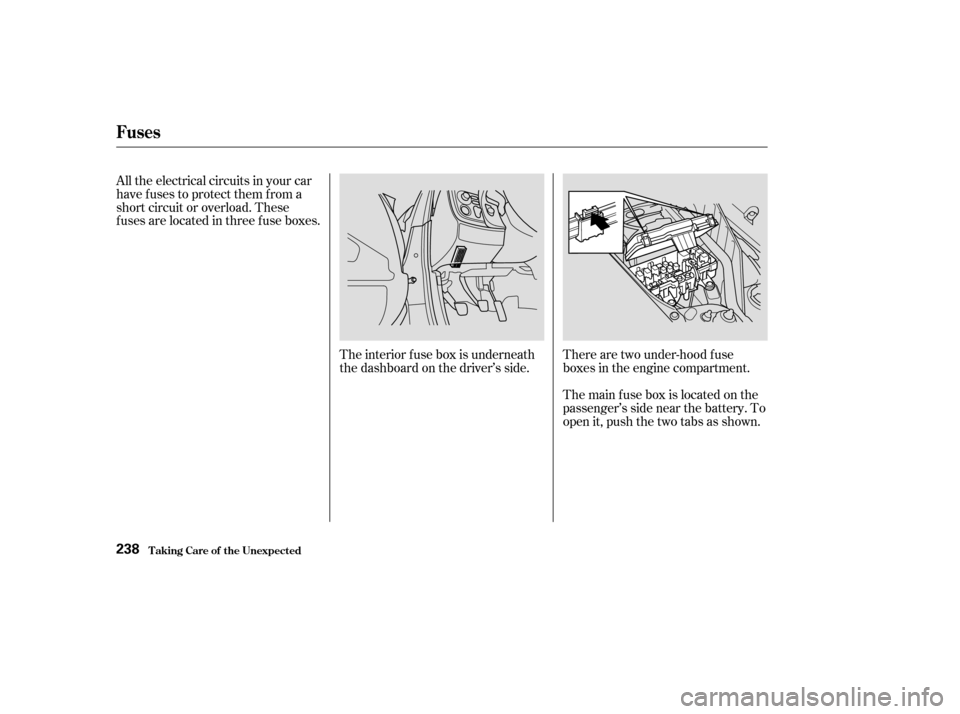
The interior f use box is underneath
the dashboard on the driver’s side.There are two under-hood f use
boxes in the engine compartment.
Themainfuseboxislocatedonthe
passenger’s side near the battery. To
open it, push the two tabs as shown.
All the electrical circuits in your car
have fuses to protect them from a
short circuit or overload. These
f uses are located in three f use boxes.
Fuses
T aking Care of t he Unexpect ed238
Page 242 of 280

The auxiliary f use box is located on
thedriver’ssidenearthebrakefluid
reservoir. To open it, push the tab on
each side and remove the lid.If something electrical in your car
stops working, the f irst thing you
should check f or is a blown f use.
Determine f rom the chart on pages
and , or the diagram on the
fuse box lid, which fuse or fuses
control that component. Check those
f uses f irst, but check all the f uses
bef ore deciding that a blown f use is
not the cause. Replace any blown
f uses and check the component’s
operation.
Turn the ignition switch to LOCK
(0). Make sure the headlights and
all other accessories are off.
Remove the cover f rom the f use
box. Check each of the large f uses in
the under-hood f use box by
looking through the top at the wire
inside. Removing these f uses
requires a Phillips-head screw-
driver.
1.
2. 3.
241 242
CONT INUED
Checking and Replacing Fuses
Fuses
T aking Care of t he Unexpect ed239
BLOWN